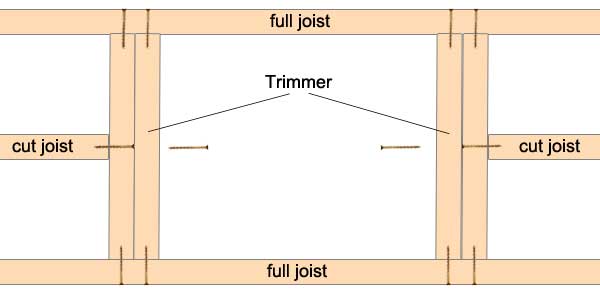There are many reasons you might need to cut ceiling joists, and it is important to understand what can be done, without damaging their structural integrity.
So, first things first, can ceiling joists be cut? The simple answer is yes. There are several instances where you may need to cut into ceiling joists, this could involve cutting the joist entirely, or just cutting small notches. Three of the main examples would be:
- Creating an opening in the ceiling – This could be for a few different reasons including adding a staircase or installing a loft hatch.
- Carrying out repair work – There will be instances where joists have become damaged or defective and need replacing. This could involve cutting and replacing sections, or even replacing entire joists.
- Cutting notches or drilling holes – This is often required to run pipes and wires above ceilings and under floorboards. However, there are building regulations that need to be followed to ensure this is done safely.
With all the above, there are certain safety precautions you should follow, to make the joists safe after they have been cut.
Cutting ceiling joists to create an opening

This is the most common time that joists will be cut. The main reasons would be to create access from one floor to another. So, adding a staircase, or a new loft hatch/loft ladder.
The process for either of these jobs will be very similar. You will need to trim the joists back to form the opening. To do this you will need access to the joists. This means they should be exposed from above and below. So, you will need to remove a section of ceiling, and flooring, if there is a floor above.
Once you have access to the timbers you can mark the opening and trim the joists back.
It is important to note, that once joists are cut you should not apply any weight above them, as a cut joist will offer no support. You may choose to add supports below to provide a stable platform for the cut joists. This can be done with some timber boards and acrow jacks.
Once you have cut the opening, you will need to add trimmers. A trimmer is a piece of timber that spans between the complete joists either side, and across the ends of the cut joists. This trimmer piece will be fixed into the joists either side, as well as the ends of the trimmed joists. You should also use joist hangers to make the opening even stronger.
Once this process is complete, the cut joists will be completely supported by the rest of the ceiling joists and the trimmers.
Cutting ceiling joists for repairs
Another reason for cutting joists, is when they need replacing or repairing. This will often need doing if the timbers have become damaged. Common reasons for repair are, rot, woodworm, or even improper cutting or notching.
One way you may notice damage to joists. is movement or bouncing in the floor when you stand in certain areas.
Depending on the extent of the damage, you will either need to repair, or completely replace the joists. Either way, you will need to cut the joists. If you are replacing entire joists, this is a big job, and you will need complete access to the entire span of the timber. This will often mean removing a large portion of the ceiling and flooring above. In some cases, you will remove everything.
If you are repairing, you will still need a good amount of access, as you will need to run timber alongside the existing joists.
The most common way to repair joists is another form of trimming, often called sister joists. This is a fairly simple process which can be seen below:
- First you cut away the damaged section of joists
- Next you cut a replacement piece of the exact same size
- You will then cut a longer piece of joists that will overlap the new piece and original joist joint by 1M.
- The longer piece of new joist will run along side the existing joist and new replacement section. This will then be bolted into both pieces creating a solid, straight joist.
Can you cut notches in ceiling joists?
The final instance you may cut a ceiling joist is if you are notching out for wires or pipes. This is quite common and is allowed by building regulations. However, there are rules for notching and drilling that must be followed:
- You should only cut into the top of joists, never the bottom.
- Notches should be a maximum of 0.125 the depth of the joist
- Any notches should be between 0.07 and 0.25 the span of the joist from a supporting structure.
- Holes can be drilled through the centre of the joist, but can be no bigger than 0.25 the depth of the joist
- Any holes should be between 0.25 and 0.4 the span of the joist from a supporting structure.
As you can see, the size and position of holes and notches, is determined by the span and depth of the joists they are being applied to. Therefore, you will need to measure and work out what is allowed in the joists you are cutting.
Conclusion
There are many instances where ceiling and floor joists may need cutting, and it is completely fine to do, providing you are following all the relevant building regulations.
If you are unsure about how to do the job safely, you should speak with a professional carpenter or builder. With that said, removing part of an individual joist will not have much of an impact on the entire ceiling.
Ceilings and floors are designed to spread load. This means that a cut joist will be supported by the rest of the ceiling. Obviously, you should not stand on a cut joist, but the joists around it will be unaffected.
Also, a properly trimmed joist will be just as strong as a complete joist. This is because, it is supported by the timbers that run alongside of it. A perfect example of this, is a stairwell opening. This opening is very strong and supported, despite several trimmed joists to form the opening.




